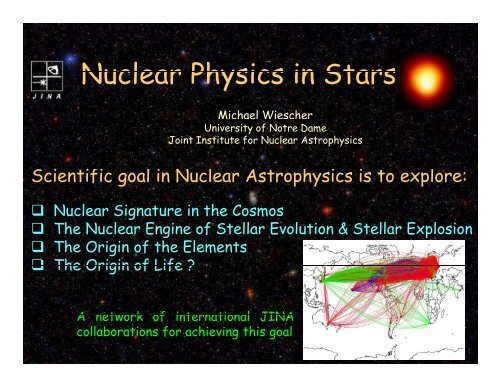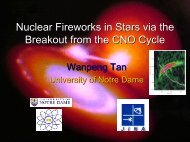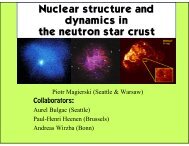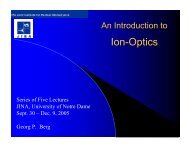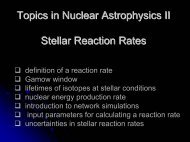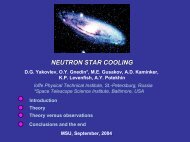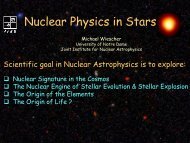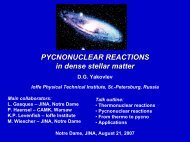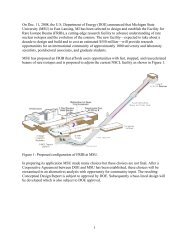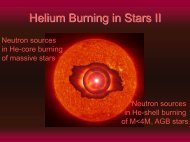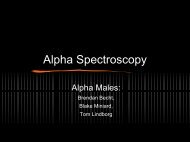JINA Science - The Joint Institute for Nuclear Astrophysics
JINA Science - The Joint Institute for Nuclear Astrophysics
JINA Science - The Joint Institute for Nuclear Astrophysics
You also want an ePaper? Increase the reach of your titles
YUMPU automatically turns print PDFs into web optimized ePapers that Google loves.
<strong>Nuclear</strong> Physics in Stars<br />
Michael Wiescher<br />
University of Notre Dame<br />
<strong>Joint</strong> <strong>Institute</strong> <strong>for</strong> <strong>Nuclear</strong> <strong>Astrophysics</strong><br />
Scientific goal in <strong>Nuclear</strong> <strong>Astrophysics</strong> is to explore:<br />
<strong>Nuclear</strong> Signature in the Cosmos<br />
<strong>The</strong> <strong>Nuclear</strong> Engine of Stellar Evolution & Stellar Explosion<br />
<strong>The</strong> Origin of the Elements<br />
<strong>The</strong> Origin of Life ?<br />
A network of international <strong>JINA</strong><br />
A network of international <strong>JINA</strong><br />
collaborations <strong>for</strong> achieving this goal
time<br />
Nucleosynthesis History
Signatures of Nucleosynthesis<br />
<strong>The</strong> origin and <strong>for</strong>mation<br />
of the elements is the main<br />
signature <strong>for</strong> nuclear<br />
physics in the Universe!<br />
<strong>The</strong> light emission of stars<br />
and stellar explosions<br />
reflects the role of stars<br />
as nuclear power plants!<br />
Abundan ance<br />
galactic abundance distribution<br />
10 10 stellar H-, He, C, O, Si-burning<br />
10 5<br />
10 0<br />
cosmic rays<br />
10 -5<br />
stars, supernovae<br />
s-process<br />
He-burning in AGB stars,<br />
massive stars<br />
p-process<br />
site disputed<br />
r-process<br />
type II supernovae,<br />
merging neutron stars<br />
0 50 100 150 200<br />
A
Cosmo-Chemistry of Meteorites<br />
AGB-Stars<br />
Supernovae<br />
Novae
Spectroscopy surveys of stars<br />
in our and far distant galaxies<br />
Observation of nucleosynthesis products<br />
through h survey and detailed d analysis!<br />
ARC 2.5m SDSS Telescope (3 deg FOV)
Light and Light-Curves<br />
Light intensity correlates with energy-output<br />
Light curve follows the radioactive decay law 56 Ni, 56 Co, 44 Ti
<strong>The</strong> (radio) active Universe<br />
COMPTEL<br />
INTEGRAL<br />
1 MeV-30 MeV<br />
γ-Radiation in Galactic Survey<br />
( 26 Al Half life: 700,0000 years)<br />
44 Ti in Supernova Cas-A Location<br />
(Half life: 60 years)
Stars & Stellar Explosions<br />
are Cosmic Cauldrons
<strong>Nuclear</strong> processes are the engine of the Universe !<br />
the looks<br />
Nuke-2009<br />
and the engine
Simulation of stellar processes<br />
in laboratory environment<br />
Comparison with observational results and<br />
Comparison with observational results and<br />
interpretation through computer modeling
<strong>Nuclear</strong> Reactions in Stars<br />
• generate energy<br />
• create new isotopes and elements<br />
p<br />
13 12 N<br />
C<br />
γ<br />
12 C(p,γ)<br />
13 N<br />
reaction probability ⇒<br />
σ: reaction cross section<br />
(in unit barns=10 -24 cm 2 )<br />
11
<strong>Nuclear</strong> burning & stellar evolution<br />
10<br />
Si-ignition<br />
O-ignition<br />
iti<br />
Ne-ignition<br />
9<br />
C-ignition<br />
log (T<br />
c )<br />
He-ignition<br />
8<br />
H-ignition<br />
7<br />
0 2 4 6<br />
8 10<br />
log (ρ c )<br />
Each burning phase is determined by nuclear reactions in terms of<br />
energy generation,<br />
time scale<br />
nucleosynthesis
Neutrinos from the Sun<br />
Neutrino Sources in the Sun:<br />
1<br />
H(p,e - ν) 2 H (total)<br />
3<br />
He(3He,2p) 4 He (pp-I)<br />
3 He(α,γ) 7 Be (pp-II<br />
7<br />
Be(p,γ) 8 B (pp-III)<br />
14<br />
N(p,γ) 15 O (CNO)<br />
Neutrino detectors<br />
Borexino, Gran Sasso, Italy<br />
SNO, Canada, and<br />
Superkamiokande, k Japan
Reactions in red Giant Stars
<strong>The</strong> last Days of Stellar Burning<br />
ng<br />
dissolution of burning shells and<br />
mixing of matter with as yet<br />
un<strong>for</strong>eseeable consequences!<br />
Convective Boundary<br />
Burning Zones<br />
Dave Arnett; Santa Barbara, “<strong>The</strong> last Days of Burning”<br />
http://www.jinaweb.org/events/ucsb06/talks_SB06.html
Massive Stars Collapse<br />
re-bounce and shock<br />
driven by neutrino wind pressure
-process production of heavy<br />
elements in supernova shock<br />
Abundance distribution in<br />
metal-poor (old) galactic<br />
halo stars matches solar<br />
r-process abundances!<br />
➱ unique r-process site!
Detection of 60 Fe<br />
with INTEGRAL<br />
60<br />
Fe enrichment in deep sea<br />
iron manganese sediments<br />
Observation of<br />
60 Fe by radioactive decay<br />
t 1/2 =1.5 Myr
Observational evidence <strong>for</strong> a nearby<br />
Supernova 28 2.8 Myr ago at a distance<br />
of ~10pc!<br />
<strong>The</strong> oldest “walking”<br />
human ancestor<br />
Australopithecus afarensis
Nucleosynthesis in supernova shock<br />
Important model parameter <strong>for</strong> abundance predictions<br />
masses, shell closures T 1/2 , P n , (n,γ) & ν-processes!<br />
Production of ~50% of heavy elements
X-Ray Bursts as<br />
<strong>Nuclear</strong> Laboratory<br />
97-98<br />
2000
HCNO & rp-Process
Elements in our Galaxy
Astrobiology At bil in<br />
Cosmic Bombardment<br />
NASA astrobiology observation program
New Initiatives:<br />
Cosmic Ray Simulations<br />
Accelerators provide<br />
5 MeV Radiation distribution<br />
interactioni<br />
Bombardment of asteroid material<br />
leads to the <strong>for</strong>mation of complex<br />
“organic” molecules, the first step to<br />
LIFE - Astrobiology
Each heavy atom in our body was build<br />
and processed through ~40 supernova<br />
explosions since the beginning of time!<br />
W d f ff<br />
We are made of star stuff<br />
Carl Sagan


